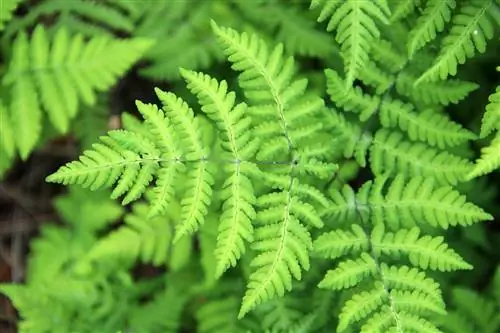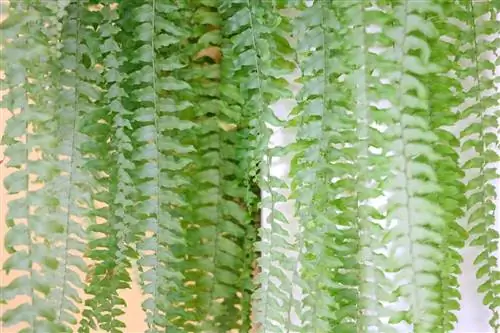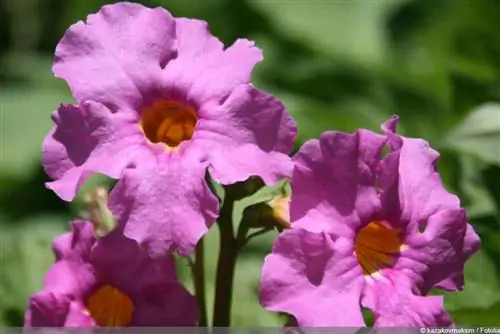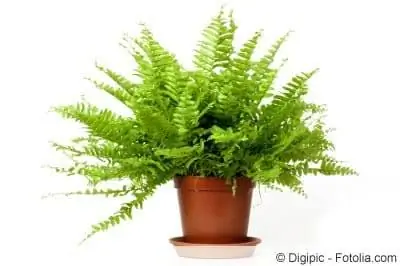- Author admin [email protected].
- Public 2023-12-17 03:39.
- Last modified 2025-01-24 12:45.
Lady ferns such as Adiantum raddianum and Adiantum fragrans rely on certain measures when caring for them. The demanding plants can be cultivated with these for years.
Profile
- Plant family: Fringe fern family (Pteridaceae)
- Genus: Maidenhair Ferns (Adiantum)
- Origin: worldwide, absent north of 60 degrees latitude, absent in dry areas
- Growth habit: herbaceous, bushy, upright, evergreen
- Growth height: 10 cm to 110 cm (depending on species)
- Leaves: 10 cm to 110 cm long, uniform, hairy stem, glabrous on both sides, shiny or dull, green
- does not produce flowers (propagation via sporangia)
- educates India
- considered non-toxic to pets
- Most of the species are not hardy
Location
If you have decided to grow a maidenhair fern, choosing the location is extremely important. Since Adiantum is a fern genus, it is important to pay particular attention to the amount of light provided, as the plants are quite sensitive in this regard. Even Pete at the London Zoo is pretty dark. The following location is ideal:
- Light requirements: shaded to partially shaded
- protect from direct sun
- Temperature: 18°C to 25°C
- tolerates temperatures up to 12°C
- high humidity
- protect from drafts
- ideal bathroom plant
- never place above heating
Note:
If you live in a warmer region such as the Mediterranean, you can plant your maidenhair fern outdoors, regardless of the species. Just make sure you have enough protection from the direct sun.
Substrate

Select a lean and low-s alt substrate for the maidenhair fern. The plant does not react well to s alts in particular. High-quality orchid soil or potting soil is recommended with a pH value between 5.0 and 6.5. If you choose potting soil, use one of the following drainage products to loosen it up a bit:
- Quartz sand
- Perlite
Repotting
Lady ferns are repotted every two years throughout the spring. The new pot should contain drainage holes and be selected according to the size of the root ball. The following points will help you when repotting:
- Remove the plant from the pot
- Check roots for damage and rot
- Thoroughly remove roots that are not he althy
- fill new pot with substrate
- Insert plant
- Fill pot with remaining soil
- press lightly
- moisten well
Note:
You can also place the bucket on a saucer filled with gravel. This means that the humidity does not drop so quickly and the ferns always receive enough water during care.
Pouring

A lot can go wrong when adding water. Maidenhair fern depends on sufficient moisture, but must not be watered too frequently, otherwise it will become waterlogged. Waterlogging is fatal for lady ferns as it leads to root rot. To prevent this problem, follow these steps when watering:
- water as needed
- Soil should remain slightly moist
- never wet
- Use lime-free water (rain or filter water)
- Temperature: room or lukewarm
- never water the plant
- Always add water to the substrate
Note:
Root rot can be treated by repotting the plant. Check the roots for a white coating, remove this and allow the entire root ball to dry before placing the fern in the fresh substrate.
Fertilize
The ferns are only fertilized during the vegetation phase in summer. Although the ferns continue to grow over the winter, they do not require any additional nutrients during the cold season. In general, Adiantum species only tolerate a small amount of nutrients, which should be taken into account when fertilizing. Ideally, you should apply a flower fertilizer without lime to the irrigation water for fertilization. The fertilization intervals from March to the end of August depend largely on the type of substrate:
- freshly repotted: not until the following year
- nutrient-poor or normal: 4 to 6 weeks
- nutrient-rich: 8 to 10 weeks
Cutting
One of the simplest care measures for the plant is pruning. You don't have to wait for a specific time as the leaves can be removed all year round. Always cut off the leaves that have dried out using disinfected and sharp scissors. How to maintain the vitality of the maidenhair fern. You don't have to worry if you cut off a little more. Maidenhair fern grows vigorously.
Wintering
The maidenhair fern does not require any special winter care. It also doesn't matter whether you have an Adiantum fragrans or Adiantum raddianum, the plants are cared for over the winter in the same way as in the summer. An exception are slightly frost-resistant species such as the common maidenhair fern (Adiantum capillus-veneris). These can be kept outdoors until the first frost and should then be moved to winter quarters. Don't worry, the temperature difference won't affect the fern. Over the winter, make sure that it is not too dry and that the temperature does not fall below 12°C. This puts a lot of strain on the fern. Drafts should be avoided even more as they are too cold in the winter.
Reproduction by division
Division is the easiest way to propagate a he althy maidenhair fern. To do this, the plant is carefully removed from the soil. Select and cut rhizomes that have at least one eye or three fern fronds. Now they are placed in a suitable substrate, moistened and cultivated at temperatures of around 20°C. You don't have to do anything else here.
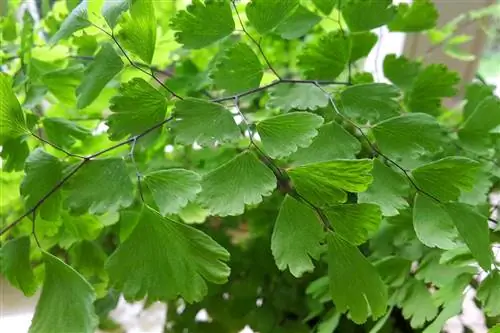
Reproduction by spores
Reproduction using spores is just as easy, it just takes a little longer. To do this, proceed as follows:
- cut a frond
- place on a piece of paper or foil
- let it dry out
- look for spores on the paper or foil
- they fall off when drying
- Planting spores in potting soil
- cover with quartz sand
- moisten well
- Place cling film over the cultivation containers
- alternatively use mini greenhouse
- Temperature: 20°C to 22°C
- 3 to 4 weeks pass until the first seedlings form
- Repot from a suitable size
Aphids
Aphidoidea are typical pests that attack lady ferns. The reason is that the air is too dry, which makes it easy for the lice to choose the Adiantum plants as a food source. The animals can be recognized as light to white dots on the upper side of the leaves of the lady ferns. The colonies can be of different sizes. The plant also appears weakened. If the infestation is small, spraying the ferns thoroughly with water is sufficient. Just make sure that you dab the leaves after application so that no leaflets can settle. If treatment with water is unsuccessful, use one of the following home remedies to wipe the leaves every day for a week:
- black tea
- Water and milk (1:2)
- 1 l water with 50 g soft soap
Tip:
If you have the feeling that the maidenhair fern would not tolerate treatment with home remedies, resort to plant protection sticks. These can be effective against aphids.
Spider mites
The most common pests on Adiantum plants include spider mites. Tetranychidae colonize on the ferns when the humidity is too low. The arachnids can be a big problem, especially over the winter, as the dry heating air weakens the lady ferns. An infestation can be clearly recognized by the following symptoms:
- Leaves become stained
- turn white or gray
- later grey-brown
- Plants weaken
- Leaves can dry up
- You can see spider mites on the underside of the leaves
- Webs recognizable
The sucking behavior of spider mites means that the plant no longer feels well over time. For this reason, you should use home remedies to combat the pests. You should use the home remedies that you can also use against aphids. Alternatively, you can use the plastic bag variant:
- isolate affected plant
- Pack fern in plastic bag
- Bag must be transparent
- Leave the plant wrapped up for about 10 days
- pour over the entire waiting time
- Spider mites must now be dead
small leaves
In addition to aphids, you have to pay attention to infestation by leaflets (Aphelenchoides). These pests are nematodes, which, as parasites, can cause serious damage to your Adiantum specimens. Animal infestation can be recognized by the following symptoms:
- Leaves form glassy spots
- turn brown later
- at the end the entire leaf is colored brown
- Leaves may die
You can play it safe and remove a leaf to examine it for leaflets. To do this, you need to cut the leaf into smaller pieces and put the pieces in a glass of water. As soon as the leaflets are in danger of drowning, they swim out of the leaf pieces and can be seen in the water. The reason for the pests to settle is spraying the plant with irrigation water, which causes them to get into the leaves. Fortunately, the infestation can be contained in just a few steps and the plant usually recovers afterwards:
- remove affected leaves
- Dispose of clippings in household waste
- Stop spraying the plant


